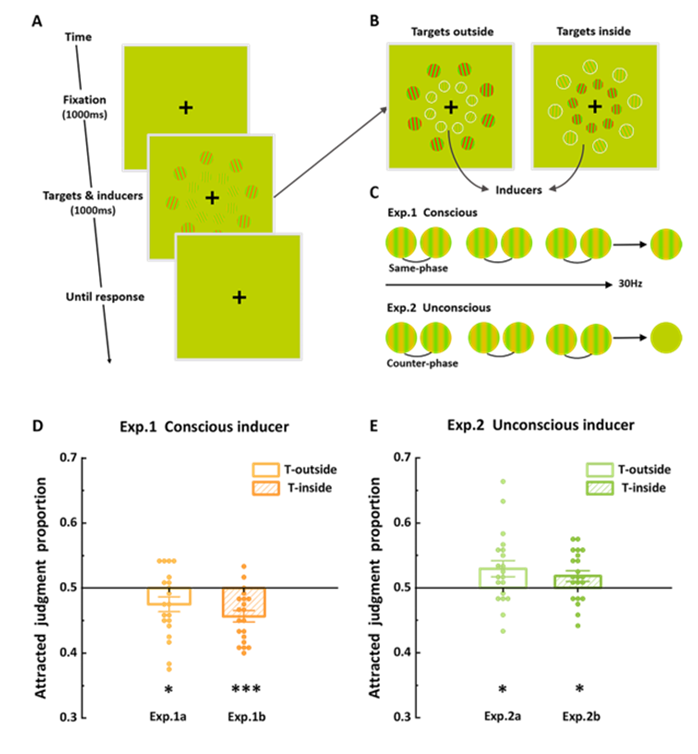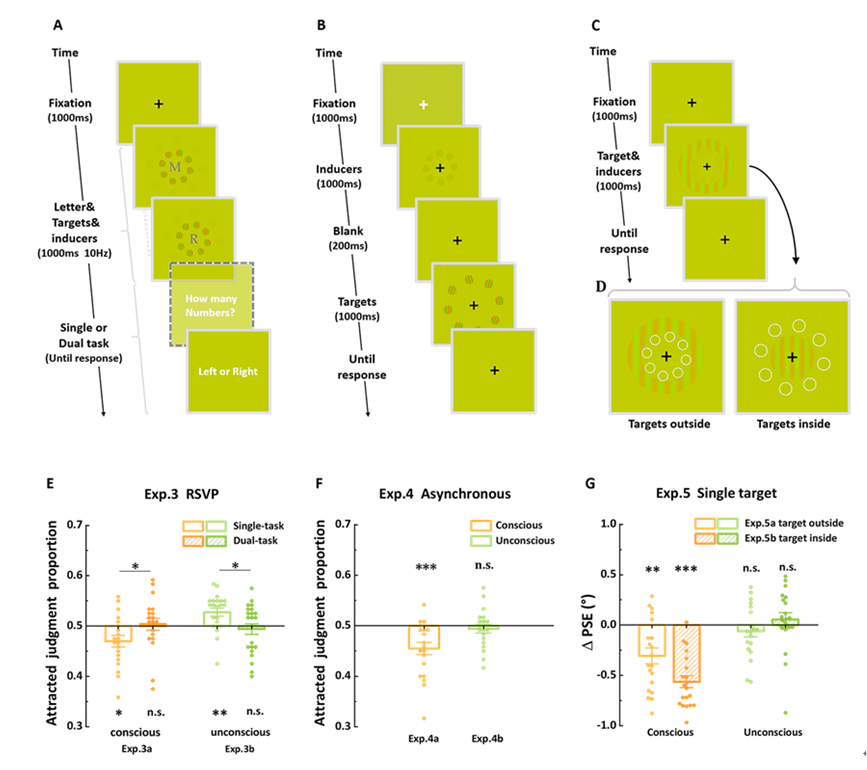Imagine when you enter a party hall and glance at the complex scene, what information could you get? It seems impossible to perceive everything precisely, but you might be capable of rapidly accessing some summary statistics of the scene, such as the overall hue and brightness, the crowd location and orientation. This ability to extract ensemble statistical information from groups of similar objects is referred to as ensemble perception.
Previous studies have shown that ensemble perception can be characterized to some extent as an automatic, compulsory process, suggesting that the summary statistics can be extracted rapidly even without intention, which help enrich our visual perceptual experience. The intriguing question here is whether the processing of non-target ensemble statistics exerts influences on the perceptual judgments of targets. More critically, what roles do consciousness and attention play in this process?
To address these questions, a research team led by Prof. JIANG Yi from the Institute of Psychology, Chinese Academy of Sciences manipulated the visibility of the stimuli using a Critical Flicker-Fusion Frequency (CFF) method and explored how conscious and unconscious ensemble statistics modulate the perceptual judgments and their cognitive mechanisms in a series of experiments.
Specifically, in Experiment 1 and Experiment 2, two arrays of gratings were presented and arranged in concentric circles, with one array of the gratings (i.e., inducers) rendered visible or invisible, to examine how the average orientation of visible or invisible inducers influences the average orientation judgments of another group of stimuli (i.e., targets).
The results showed that irrespective of the inducers positioned on the inner circle (Experiments 1a and 2a) or the outer circle (Experiments 1b and 2b), the average orientation of the conscious and unconscious inducers oppositely modulated the perceptual judgments of the vertical targets. The ensemble judgments of the targets tended to be repelled from the average orientation of the visible inducers but attracted to the average orientation of the invisible inducers (Fig. 1E).

Figure 1. Procedure, stimuli, and results of Experiments 1 and 2. Image by LIU Dingrui.
Experiment 3 manipulated the attention load of the task by introducing rapid serial visual presentation (RSVP) to investigate whether and how attentional resources affected the conscious (Experiments 3a) and unconscious (Experiments 3b) modulation effects. The results showed that in the single-task condition where participants were only required to judge the average orientation of the targets, the conscious and unconscious modulation effects were consistent with the findings of Experiments 1 and 2.
However, in the dual-task condition where participants had to simultaneously perform the average orientation judgment and the RSVP task, the conscious and unconscious modulation effects were both severely impaired (Fig. 2E). It suggests that available attentional resources are indispensable to the ensemble perception and/or the modulation effects.
Moreover, Experiments 4 and 5 found that when introducing a brief temporal gap between the presentation of the inducers and the targets, or amplifying the distinction between the inducers and the targets (by substituting the group of target gratings with a single target grating), the attractive modulation effect triggered by unconscious summary statistics would be abolished but the repulsive modulation effect triggered by conscious summary statistics persisted (Fig 2F, 2G). These results suggest that only the unconscious attraction effect is dependent on the simultaneity and similarity between the inducers and the targets.

Figure 2. Procedure, stimuli, and results of Experiments 3–5. Image by LIU Dingrui.
Taken together, the current study demonstrates that processing of conscious and unconscious ensemble statistics differentially and even oppositely affect our perceptual decision-making, with unconscious processing of ensemble statistics inducing an attractive modulation effect while conscious processing of ensemble statistics inducing a repulsive modulation effect.
They both rely upon the available attentional resources, but only the unconscious modulation effect is highly susceptible to the target-inducer temporal separation and distinction. It indicates that perceptual decision-making on summary statistics may engage two different mechanisms in the visual system, a bottom-up mechanism that underlies the unconscious attractive modulation effect, and both bottom-up and top-down mechanisms that undergird the conscious repulsive modulation effect.
Furthermore, awareness and attention play distinct roles in ensemble perception: awareness acts as a ‘guide,’ which determines how to utilize the extract summary statistics cognitively, while attention acts as a ‘switch,’ which determines whether to extract the summary statistics from ensemble stimuli (Fig. 3).

Figure 3. A schematic illustration of the proposed mechanism for the unconscious and conscious modulation effects. Image by LIU Dingrui.
This study entitled “Conscious and unconscious processing of ensemble statistics oppositely modulate perceptual decision-making” has been published online on February 28, 2023 in American Psychologist.
LIU Chen
Institute of Psychology Chinese Academy of Sciences
Beijing 100101, China.
E-mail: liuc@psych.ac.cn
